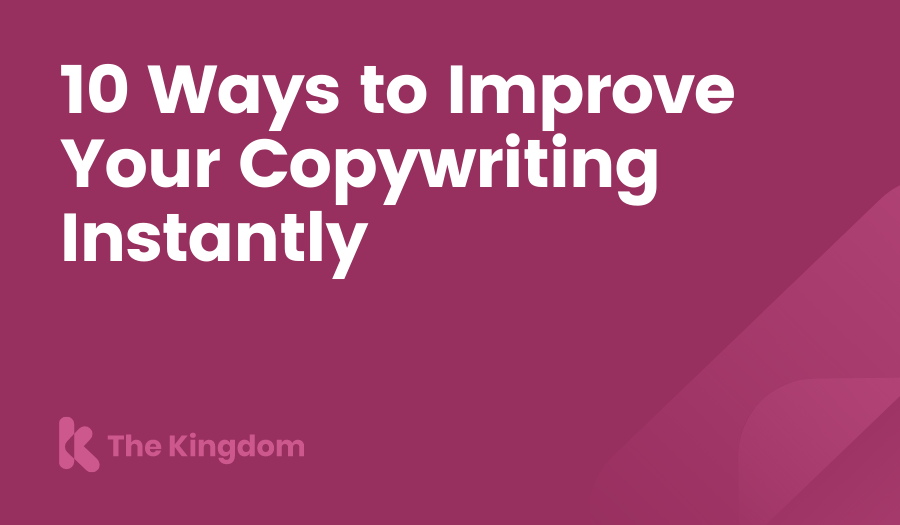Any successful inbound marketing strategy is built upon a foundation of amazing content. But if you’re new to blogging, it can be challenging to churn out a high volume of quality copywriting.
Sure, practice and experience will improve your writing, but what are some strategies you can try today to make your next post more readable and shareable?
1. Think about what your audience wants.
First and foremost, determine what your audience is looking for. Your potential readers seek out information on the internet to educate themselves, not because they love ads. If your writing is self-promotional, site visitors will run in the opposite direction.
So, how do you know what your audience wants?
Speak with your salespeople and target demographic to learn more about your audience’s biggest goals and most frustrating challenges. What bothers them on a daily basis? What obstacles do they commonly face in their work or home life?
Let the topics of your posts demonstrate that you understand their goals and challenges, and your target audience will come knocking at your virtual doorstep in no time. Once you understand their needs, you’ll be much better equipped to solve for them.

2. Do your research.
Once you’ve decided on a topic, it’s time to scope out the competition. Try using Google Advanced Search commands to dig deep into the existing content on the subject, and spend some time sifting through the top 10 search results. Make note of what the best pages cover – what unexpected content do you love? Similarly, note what you dislike about the bad pages.
Then, determine how you can improve upon the existing content. Can you explain a complicated concept in simplistic terms? Could you add a chart or visualisation to help visual learners picture the process you’re describing? Could you add a unique perspective to establish yourself as a thought leader?
If you merely regurgitate the content already appearing in the search results, there’s no reason for people to read your blog post over the next guy’s. But if you can contribute something valuable and unique, your post will soar to the top of the results page.
3. Open with a relatable question.
Your readers want to know that you empathise with their problems. One of the best ways to establish empathy is to ask a question that makes them nod and say, “Yes, that’s me!”
When you ask a question early on, you accomplish two things:
- You bring your audience into the narrative. Suddenly, your article becomes about solving for the reader, not any random person.
- You show that you want to help. You’re no longer begging for trust, you’re earning it. You’re about to provide the solution to a challenge your readers are facing, and now they want to hear it.
Questions bring your readers on board by giving them the feeling that you care about them personally and want to help.

4. Use positive language.
Great content doesn’t dwell on problems; it provides insight into their potential solutions.
If I’d named this post, “10 Reasons Your Content is Absolutely Terrible” and merely described things that most people do badly when they’re writing without offering actionable advice, you might feel discouraged and incapable. Where’s the value in that?
Feel free to publish articles that outline common mistakes, but be sure to provide solutions. If people are searching for ways to improve their copywriting, they want actionable ideas, not just a run-down of everything they’re doing wrong.
When you provide an optimistic perspective on a problem, you excite your readers, energising them to take action on the tips and tricks you’re providing.
Moreover, happiness is contagious. Use happy language and you’ll leave your audience feeling better than when they clicked on your article, and they’re far more likely to come back.
5. Get personal.
Throughout our schooling, we’re told that third-person is the appropriate tense in the adult world. I’m here to tell you to throw that advice out the window when you’re writing blog content.
True – it’s grammatically correct and applicable to everyone, but it’s boring and impersonal. While the second person is less formal, it’s far more pleasant and easy to read. It reminds your audience that you’re writing for them, driving your major takeaways home.

6. Begin sentences with words that invoke images in your readers’ minds.
Starting sentences with words like ‘imagine’ or ‘remember’ invites readers to insert themselves into the story, making the advice you’re giving them seem even more applicable to their lives.
It’s another way to relate to your audience and make the content you’re writing even more relevant to them. It will paint a clearer picture in your audience’s minds, making them feel more mentally invested in the story you’re telling.
7. Be as direct as possible.
If you can use fewer words to say what you’re trying to say, do so. Using direct language shows that you know what you’re talking about. You’re not writing for attention or to show off the English devices you learned in secondary school. You’re writing to inspire your readers to take action, solve a problem and better themselves.
8. Replace adverbs and forms of the verb “to be” with colourful action verbs.
In the interest of saving words, count the adverbs in your writing and try to cut that number in half. Pro tip: Use Hemingway to find out where your adverbs and complex sentences are hiding. Instead of pairing descriptive adverbs with boring verbs, just use a verb that packs the punch itself.
Another top trick: find any forms of ‘to be’ in your writing and reword sentences wherever you can to incorporate a different verb.
Your writing will become much more action-based.
To use a couple of simple examples, you might write, “Tim baked the pie” instead of, “The pie was baked by Tim.” You might replace, “Shakespeare was the playwright who wrote Romeo and Juliet” with, “Shakespeare wrote the play Romeo and Juliet.” Much stronger sentences, right?

9. Break up lengthy paragraphs and sentences.
A long piece is far more digestible when it’s broken into bite-sized chunks. Every 1-3 sentences, take a paragraph break. It may seem like overkill if you’re used to writing formal papers or reports, but you’ll retain your readers’ attention far longer.
We’re busy people, and our eyes have adjusted over time to sift long articles for the major takeaways.
Usually, we read the first and last sentence of a paragraph, figuring the most important information will be located in one of those places.
By shortening your paragraphs, you can place more emphasis on the specific, actionable points that you want your readers to absorb.
Shorten complex sentences, too. There’s no reason to utilise extra dependent clauses when you’re writing a blog post or email. When your sentences get right to the point, the focus stays where it should: on the information you’re sharing, not the writing style.
10. Have a colleague give your article a once-over when you’re done editing to catch any mistakes you may have missed.
As writers, we get so caught up in the flow of ideas and words that we sometimes forget a simple comma here or there.
Eliminate embarrassing typos and tidy up your copy by passing along your article to colleague. He or she will see obvious mistakes and can tell you if a sentence is too complicated.
Test out these methods when you’re writing your next blog post or apply them to a piece you’ve already drafted, and watch as your copy transforms into digestible, exciting content marketing that your audience loves to read.
Discover more:
Four Steps To Get Inbound Marketing Working
How An Inbound Marketing Strategy Can Make A Beautiful Website




